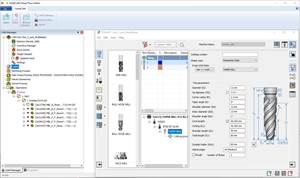Translation Software Translates Into Savings
This precision machine shop faced the prospect of purchasing a $30,000 CATIA workstation to make translations of CATIA models for their CNC programming system, or lose business.
Aero CNC, a precision machine shop in the Fort Worth, Texas suburb of Burleson faced the prospect of purchasing a $30,000 CATIA workstation to make translations of CATIA models for their CNC programming system. Their main customer, Lockheed Martin Aeronautics in nearby Fort Worth, had issued a supplier alert indicating they would no longer be making Initial Graphic Exchange Specification (IGES) translations of their CATIA models. They would provide models only in the CATIA native format. It would be up to the supplier either to work directly with the CATIA files or make translations on their own.
CATIA's IGES translators did not always provide the clarity needed by the suppliers. Entities were sometimes missing in the translated file. Lines were absent and some surfaces did not have all their nodes. When they discovered that data was missing, they instructed the CNC program to provide a best fit by interpolating over the missing data. However, they were often uncomfortable with this approximation and would have to request the missing data from the customer. They felt they had to depend upon the clarity of the model, because they often operate in a "green release" environment, working on designs that are so new that physical prototypes are not available for reference.
The aerospace components that they machine for Lockheed range from bulk heads and ribs to longerons (fuselage framing members) and canopy latches. They have worked on more than 220 different parts from Lockheed. The shop performs complex, multi-axis surfacing on the components, for example, when generating swarf contours, which are formed by attaching a series of lines from any number of cross sections and any number of planes. They also perform five-axis contouring, revolved and swept tool paths, Coon's patch tool paths and others. The shop holds tolerances of at least ±0.005 inch and often work with tolerances of ±0.0002 inch. The shop also machines difficult materials—Inconel, titanium, 13-A aluminum and others.
While searching for a cost-effective means of making CATIA translations, they heard about an application-independent CATIA/IGES translation software that did not require a CATIA license. Additionally, the software ran under Microsoft Windows 95, the platform in use at the shop, and Windows NT, a platform they were planning on using later. The software, IGES/CAT (from Compunix, Inc., Southfield, Michigan) translates CATIA v.4.0 data files (export and model files) into IGES 5.1 compatible files.
They took Compunix up on the company's trial offer, which gave them a full working system to use for 30 days. After they downloaded the translator from the Compunix website, it only took them two days to become proficient with it.
As the software performs translations from CATIA to IGES, it substituted, or "mapped," the best alternative IGES entities for the CATIA entities that differed from the IGES standard.
Aero CNC reports that the software has increased their profitability, giving themtwo major sources of savings. First, they did not have to purchase a $30,000 CATIA seat. Second, they have cut about 30 percent of the time it took to translate files, since they did not have to extensively check the models or perform any re-work on them. In terms of time savings alone, the software paid for itself in a month. Aero CNC's customers have been impressed with their speed and quality of finished product and when the time comes to approach other CATIA-based businesses, they will have a selling point of using their CATIA files without their having to become involved in translations.
Related Content
Building A Powerful Bridge from the CAM Programmer to the Shop Floor Operator
SolidCAM for Operators provides a powerful bridge from CAM programming to the shop floor to best streamline the machine shop process with its CAM part simulation. It provides a clear picture to the operator for setup and prove-out, enables minor G-Code changes and avoids crashes, broken tools and scrapped parts.
Read MoreWhen to Use Custom Macros With a CAM System
Custom macros can offer benefits even when using a CAM system to prepare programs – but must be implemented with the right considerations.
Read MoreIMTS Takeaways From the Modern Machine Shop Editorial Team
The first in-person IMTS in four years left the MMS editorial staff with a lot to digest. Here are a few of our takeaways from the show floor.
Read MoreFearless Five-Axis Programming Fosters Shop Growth
Reinvestment in automation has spurred KCS Advanced Machining Service’s growth from prototyping to low-and mid-volume parts. The key to its success? A young staff of talented programmers.
Read MoreRead Next
3 Mistakes That Cause CNC Programs to Fail
Despite enhancements to manufacturing technology, there are still issues today that can cause programs to fail. These failures can cause lost time, scrapped parts, damaged machines and even injured operators.
Read MoreThe Cut Scene: The Finer Details of Large-Format Machining
Small details and features can have an outsized impact on large parts, such as Barbco’s collapsible utility drill head.
Read More

























